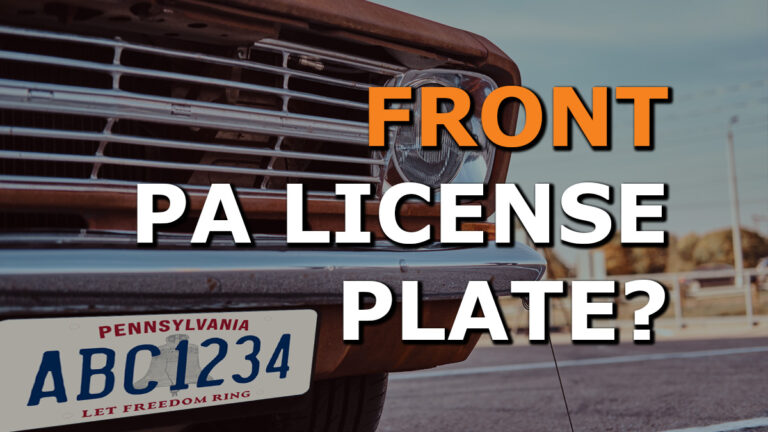Comparing the Costs and Impact of Adding Front Plates Across the U.S.
A proposed bill in Pennsylvania could soon bring a significant change to every driver in the state: the requirement to display two license plates on each vehicle—one on the front and one on the rear—of all vehicles.
The move, according to its sponsor, State Sen. Katie Muth (D-44th District), aims to improve public safety, assist in hit-and-run investigations, and enhance toll collection across the commonwealth.
But as with any regulatory change, drivers are left wondering: Will it cost me more?
The Push for Front Plates
Sen. Muth’s motivation is rooted in public safety.
In her announcement, she cited increasing rates of hit-and-run crashes—especially in urban areas like Philadelphia, where the city saw 39 pedestrian deaths from hit-and-runs in 2023, a significant increase from 21 in 2021.
“Far too often there are hit-and-run accidents, traffic incidents, or crimes committed where only the front of a vehicle is captured by cameras or witnesses,” Muth wrote. “Requiring a license plate on the front of a car will improve vehicle identification and enhance public safety.”
Front license plates may also help with toll collection in an era where plate-reading cameras are replacing toll booths.
Currently, most Pennsylvania drivers only need to display a rear plate, a law in place since 1952, though exceptions exist for state-owned, press, and some commercial vehicles.
How Much Could This Cost Drivers?
If the bill becomes law, the big question is: will drivers be charged more for that second plate?
Here’s what we know so far:
- Sen. Muth’s memo does not specify any additional cost to drivers for a second plate.
- In many two-plate states, the cost is already built into existing registration fees, with no extra charge for the additional plate.
- However, implementing a second plate system would likely increase production costs for PennDOT. Those costs could eventually trickle down to drivers unless offset by legislative funding or adjustments in state budgets.
If Pennsylvania chooses to follow other states’ models, drivers may not see a fee hike, but it’s not guaranteed.
License Plate Laws: State by State
Pennsylvania isn’t alone in reconsidering its license plate policy. Here’s how the U.S. currently breaks down:
- 29 states require both front and rear plates.
- 21 states, including Pennsylvania, only require a rear plate.
States requiring two plates include:
- New York
- New Jersey
- Maryland
- California
- Illinois
- Washington
- Oregon
States with rear-only plates include:
- Pennsylvania
- Florida (though legislation is pending)
- Arizona
- Michigan
- Georgia
- South Carolina
Cost Comparisons: One Plate vs. Two
While it’s hard to compare exact plate-related fees across all states due to bundled registration structures, here’s a snapshot of registration and plate costs in states with two plates vs. those with one:
| State | Plates Required | Average Registration Cost (Annually) |
| Pennsylvania | Rear only | $39 |
| New York | Front + Rear | $26-$140 (based on weight) + $25 plate fee |
| California | Front + Rear | $60 + varied local fees |
| Florida | Rear only (pending) | $14.50 – $32.50 + $28 plate fee |
| Texas | Front + Rear | $50.75 base + local fees |
| Georgia | Rear only | $20 base + local taxes |
Most two-plate states already include plate production in standard registration fees. If Pennsylvania follows suit, the shift to two plates may not increase annual costs significantly, especially if lawmakers adjust current fee structures or allocate funding for implementation.
Design Concerns and Pushback
Another sticking point for drivers is vehicle design. Many cars sold in Pennsylvania don’t come with front plate brackets, which would require aftermarket installations or drilling into bumpers—an unpopular move for car enthusiasts or luxury vehicle owners.
This concern has historically been one of the reasons Pennsylvania—and other states—have avoided front-plate mandates.
For now, no formal legislation has been introduced, but Pennsylvanians should prepare for the possibility that their next vehicle inspection might require not just a clear rear plate—but a front one too.
Would you support a two-plate requirement in Pennsylvania if it helped solve hit-and-run cases? Let us know in the comments or tag us on social media with your thoughts.
CNS Licensing Makes It Easy!
Whether you drive a standard car, truck, or want a personalized plate, we’ve got you covered. CNS Licensing is an authorized PennDOT agent, which means:
- Fast, in-person service
- Walk-ins welcome — no appointment needed
- Personalized plate ordering available
- We’ll handle the paperwork for you
Stop by today at one of our two locations to order a plate:
CNS Licensing – Lititz
151 Koser Rd, Lititz, PA 17543
Carolyn’s Notary Service – North Lititz
58 Copperfield Cir, Lititz, PA 17543




